This article is about how to prepare Chow Mien (or Chow Mein) which is the American-Chinese version of fried noodles, which were named based on the Chinese character 炒面 means fried noodles.
It is far too general to order a plate of Chow Mein in Asia because there are so many varieties, and the restaurant will not know what to cook for you. It is like you order a pasta without specifying how it is cooked.
However, the transliteration of this Chinese word does means a specific style of noodles if you are in the English speaking countries. This recipe is about the style of Chinese stir-fry noodles prepared by the Chinese living in English-speaking countries in general.
You should not expect the exact way of cooking found anywhere in China, as Chow Mein is a variation that has been modified and conforms to the local tastes outside China.
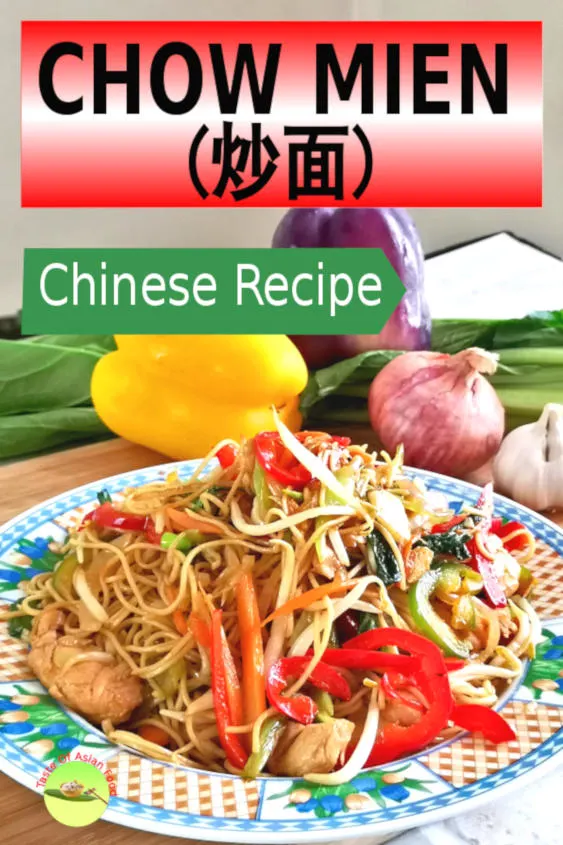
Note: This post may contain affiliate links. Please read my privacy policy for more info. I may receive commissions for purchases made through links in this post.
The components of chow mein
This recipe comprises three groups of ingredients: the protein, the vegetables, and the sauce. Let’s look at each of them in detail.
The protein
The most common source of protein is pork and chicken, followed by beef. Tofu is often the alternative for vegetarian chow mein. Other than that, shrimps, squids and occasionally scallop are the favorite seafood for chow mein.
Most of the recipes will include only one type of meat, but tofu, and seafood are often added in addition to meat. Since stir-frying is a quick cooking process, the meat, tofu, and seafood are cut into small pieces of the same size, so that they will be cooked evenly in a short time.
Marinate the meat
Cut the meat (either pork, chicken, beef) into thin slices, across the grain. Marinate with light soy sauce, ground white pepper, and some cooking oil for at least fifteen minutes.
Marinate helps to tenderize and let the seasonings absorb by the meat. The soy sauce, pepper, and oil are the essential ingredients. You will find other items such as egg whites, baking soda, cornstarch, rice wine, sesame oil in different recipes. All these ingredients will produce a different set of flavor which are typical in Chinese cooking.
Cornstarch and egg whites add a velvety texture to the meat. However, excessive cornstarch will cause the meat stick to the wok/pan easily during stir-frying. Therefore I prefer not to use it unless I cook with plenty of oil like in the restaurant.
Baking soda can tenderize the meat. It is useful, especially for marinating beef and chicken. It will not impart any taste since a small amount is sufficient. However, if you want to make sure the taste of baking soda is not present, rub the baking soda with the meat first before adding other seasonings. Let it sits for twenty minutes and wash away the baking soda before marinating the meat.
Marinate for fifteen minutes should be enough as the meat are cut into thin slices.
Wash the shrimps with baking soda
There are two methods to prepare the shrimps in Chinese restaurants. The first method is to shelled, washed, and deveined the shrimps without going through other treatment. The texture is similar to crab meat.
There is another method which can make the shrimps springy and crunchy. Soak the shrimps in water with a small amount of salt and baking soda for fifteen minutes. You decide which texture of the shrimps you want. The crunchy texture is well accepted by the Chinese. Most of the dim sum chefs like to prepare the famous Har Gow (shrimp dumpling) with crunchy shrimps.
The vegetables
Chinese likes leafy vegetables like Choy sum and bok choy, which are frequently used to prepare fried noodles. Include at least one of them into the recipe.
Other commonly used vegetables for chow mein are cabbage, carrots, capsicum (bell pepper), bean sprouts, Chinese chives, and scallions. Cut all the vegetables into strips.
We will use some of the vegetables above for our recipe. There are other vegetables in some non-Chinese fried noodles, which I have mentioned in other articles. Some of them include groundnuts, potatoes, cockles, fish cakes, and Chinese sausages. Please check out the Singapore noodles, Char Kuey Teow, and Pad Thai on this blog.
Start to stir-fry the vegetable that needs the longest time to cook. I will start with carrot strips and leafy vegetables. Bean sprouts, Chinese chives, and scallions need only flash stir-fry, which should add in the last thirty seconds.
Bean sprouts have another usage in stir-frying the noodles. If the noodles are about to stick to the wok/pan, add a handful of bean sprouts to the noodles and they will immediately free from sticking. It works because it contains plenty of water, and at the same time, separate the noodles from the surface of the wok.
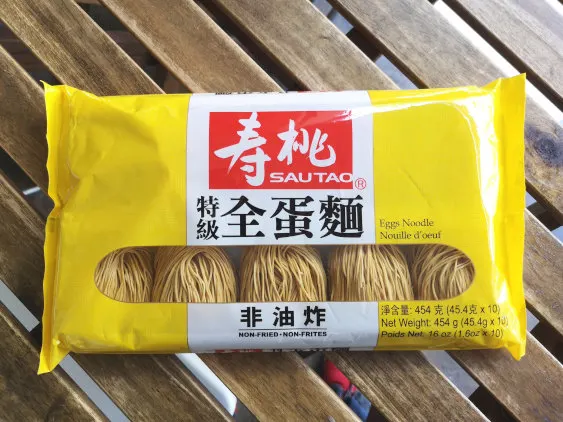
WHAT KINDS OF NOODLES TO USE?
Dry noodles
If you choose to use dry noodles, soften the noodles according to instruction on the packaging.
In general, most of the dry noodles are too hard to stir fry directly. If you use dry egg noodles, make sure you follow the package instructions to boil the noodles first.
You need to either soak or blanch in water before using it. The time required depends on the types and thickness of the noodles, which can range from two to ten minutes.
You can choose any Chinese noodles for making chow mein, not necessarily must use those labeled specifically for chow mien.
Wet noodles
Use fresh noodles if you want the best and authentic homemade Chow Mein.
Most of the wet noodles can be used directly for stir-frying. The choices are aplenty in Asia, and each of them has different texture and flavor.
I am using dry noodles in this recipe since not everyone will be able to get the wet noodles conveniently.
Make sure to cook the noodles until al dente as it will continue to cook in the wok. You don’t want them to become mushy. Transfer it immediately to a pot of cold water to stop cooking.
The simplest (and best) chow mien sauce
A great Chow Mein comes down to the sauce – it takes more than just soy sauce and sugar!
Here is a list of common ingredients to constitute the chow mien sauce. These ingredients are not only used for frying noodles but are nearly universal for all Cantonese stir-fry cuisine. Chinese chefs will use these ingredients in various proportions to create sauces with different flavors.
- Light soy sauce– Usually this is the main ingredients for the sauce. It contributes to the flavor and the saltiness. Sometimes it is replaced partially or all by the fish sauce.
- Dark soy sauce– It is much darker and thicker than the light soy sauce. It is less salty and is used primarily to add the color to the sauce.
- Oyster sauce– It is hugely popular among the Cantonese. It adds another layer of the flavor of the sauce in addition to soy.
- Fish sauce– It has strong umami and is very salty. Be careful not to add too much.
- Sesame oil– You may want to add the sesame oil at the end of cooking. That will leave a strong sesame flavor to the Chow Mien.
- Salt– It all depends on how much soy, oyster, and fish sauce you use. I usually do not use salt but add a little more light soy sauce to get to the level of saltiness I want.
- Sugar– It helps to caramelize the sauce and provide a balance of flavor to the saltiness. Be careful not to add too much, mainly if you include oyster sauce since it contains sugar.
- Ground white pepper– Always use white instead of black pepper if you are looking for the original Asian flavor.
- Rice wine– Chinese rice wine is the choice, and sherry if the excellent substitute in the event it is not available.
- Cornstarch– It acts as a thickener to help the chow mein sauce gain body and stick to the noodles. Some people prefer to stir-fry the noodles until it becomes dryer and not to use cornstarch. It is the personal preference of the chef what type of texture of the noodles they want to achieve.
You can prepare the chow mien sauce according to the formula and quantity as stated in the recipe below, then improvise with the ingredients as above once you feel the confidence to make your own.
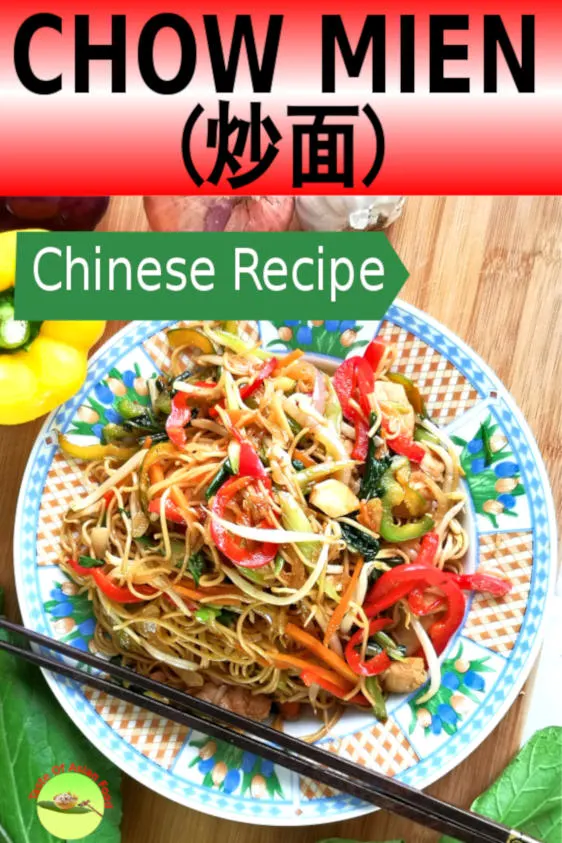
The stir-frying process
Here are the steps to prepare Chinese style chow mien in detail.
Prepare the dry noodles
- Place the dry noodles into a pot of boiling water.
- Loosen the cake of noodles with a pair of chopsticks of tongs.
- Once the noodles become al dente, remove from the boiling water and place them in cold water to stop cooking. Drained and set aside.
Prepare the ingredients
- Cut the chicken breast meat into thin slices. Marinate with light soy sauce and a small amount of cornstarch for fifteen minutes.
- Cut the bell pepper (both red and green) into long strips.
- Similarly, cut the carrots into thin strips.
- Wash the bean sprouts in water, and remove the tail at the end of it. Set aside.
- Clean the choy sum, cut it into short sections. Cut the stem into shorter sections than the leafy part so that it is easier to turn soft while cooking.
- Cut an onion into thin slices and separate them into strips.
- Crush three cloves of garlic instead of chopping if to avoid burning while sauteing.
- Prepare the chow mien sauce as indicated in the recipe.
Stir-frying
- Add the crushed garlic and onion into the wok. Once it turns aromatic,
- Heat some oil in a wok and stir-fry the chicken pieces until it turns slightly brown. Remove and drain off the extra oil.
- Add the carrot strips and continue stir-frying, follow by the choy sum, then the bell pepper.
- Add the cooked noodles, then turn the heat to medium and continue stir-frying.
- Add the chow mien sauce. Continue stir-frying and turn up the heat. Add part of the bean sprouts if you notice the noodles tend to stick to the wok. Bean sprouts help to prevent the ingredients from sticking.
- Add the chicken pieces back. Turn to high heat and stir-fry until you can smell the wok aroma rising and permeate the kitchen.
- Finally, add the remaining bean sprouts. Flash fry for fifteen seconds to keep them crunchy. Turn off the heat. Add some sesame oil and some chopped scallion to garnish. Serve.
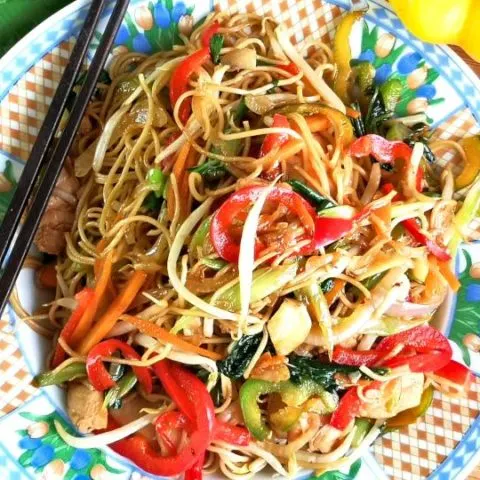
Chow Mein Recipe
This is a classic Chinese fried noodle recipe.
Ingredients
(A) For the chicken:
- 60 g chicken meat, cut to thin slices
- 2 tsp light soy sauce
- 1/4 tsp cornstarch
- 1/4 tsp salt
- A dash of ground white pepper
(B) Other ingredients:
- 2 tbsp vegetable oil
- 3 crushed garlic
- 50g onion, cut into thin slices
- 50g choy sum, cut into small sections
- 100 g dry noodles (after cooked = 220 g)
- 30 g bean sprout
- 30 g carrots, cut into thin strips
- 60g bell pepper, cut into thin strips
- 1/4 tsp sesame oil
- 10 g spring onion cut into small pieces
(C) Chow mien sauce:
- 3 tsp (15g) light soy sauce
- 1/4tsp (2g) dark soy sauce
- 3 tsp (15g) oyster sauce
- 1/4 tsp ground white pepper
- 1 tsp cornstarch
- 2 tbsp water
Instructions
Prepare the dry noodles
- Place the dry noodles into a pot of boiling water.
- Loosen noodles with a pair of chopsticks of tongs.
- Once the noodles become al dente, remove from the boiling water and place them in cold water to stop cooking. Drained and set aside.
Prepare the ingredients
- Cut the chicken breast meat into thin slices. Marinate ingredients (A) for fifteen minutes.
- Cut the bell pepper, carrots, onion into thin strips.
- Remove the tail at the end of it. Set aside.
- Clean the choy sum into short sections.
Stir-frying
- Saute the crushed garlic and onion with cooking oil. Add the chicken pieces until it turns slightly brown. Remove.
- Stir-fry the carrot strips and choy sum with the remaining oil in the wok,
- then followed by the bell pepper and the cooked chicken.
- Add the cooked noodles and the sauce (C) Continue stir-frying and slow turn up the heat further.
- Finally, add the bean sprouts. Flash fry for fifteen seconds Turn off the heat and add some chopped scallion sesame oil. Serve.
Notes
If you encounter any audio / visual problem of viewing this video, you can view it from YouTube by clicking this link, which will open in a new tab.
Recommended Products
As an Amazon Associate and member of other affiliate programs, I earn from qualifying purchases.
Nutrition Information:
Yield: 1` Serving Size: 1 servingAmount Per Serving: Calories: 648Total Fat: 34gSaturated Fat: 4gTrans Fat: 1gUnsaturated Fat: 28gCholesterol: 53mgSodium: 3058mgCarbohydrates: 57gFiber: 6gSugar: 10gProtein: 29g
This data was provided and calculated by Nutritionix on 5/14/2019

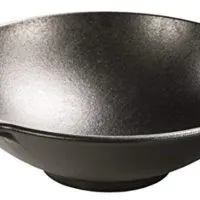
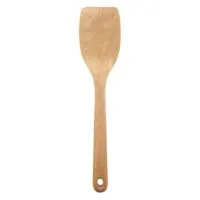
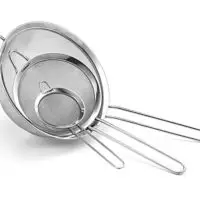

Burt
Sunday 25th of April 2021
Is it ok to use frozen prawns and scallops instead of chicken or beef in this recipe.
KP Kwan
Monday 26th of April 2021
Hi Burt, This recipe is quite forgiving. You can use any protein of your choice. KP Kwan
Supriya Kutty
Saturday 16th of May 2020
I had literally no clue so much goes into making the perfect chaumin. I had previously read various article on making a chaumin but it somehow didnt worked well After reading this article I have realised where I am missing thank you for this.
KP Kwan
Sunday 17th of May 2020
Hi Supriya, You are welcome. I hope you will cook the noodles and enjoy it. KP Kwan
PETER RANDRUP
Monday 5th of August 2019
Why is it no one can advise me on what type or brand of noodles my local Canadian restaurant uses to make retail restaurant style Chow Mein??
It's NOTHING like the Chow Mein described on websites like this one. In my British Columbia town, the "Chow Mein" has NO MEAT OR VEGETABLES in it AT ALL, except a small garnish of green onion and shaved (formed into block) chicken meat on top. The vegetables and meat etc are served separately. The "Chow Mein" you get served here is 99.999% CHOW MEIN NOODLES. And NO SAUCE at all.
What I love about this type of Chow Mein is that it is just noodles - and that they are very skinny and fairly short and DRY TO THE TOUCH....VERY SOFT AND TENDER. But they are NEVER WET. They are NOT LONG like spaghetti and they are skinnier. All the so called "restaurant" style Chow Mein being cooked on sites like this have long noodles, meat, tons of vegetables and are quite/or very wet and most often are in a sauce.
Does no one else get this type of "dry" Chow Mein in a restaurant? I have been eating at our town's Chinese Restaurant since I was about 10 yrs old - so about 47 years! That' the only style of "CHOW MEIN" that I know. I want to be able to make it myself. Please help!
KP Kwan
Tuesday 6th of August 2019
Hi Peter, I am unable to provide reliable advice as I am living in Asia. In general, any dried egg noodles should be fine. Your local Asian grocery shopkeeper should be familiar with the local brands. KP Kwan
Lim Kian Hin
Saturday 18th of March 2017
Thank You so much . Mr Kwan.
Lim Kian Hin
Saturday 18th of March 2017
Dear Mr Kwan.
I read up your Recipe. And tried attempt Chow Mein. The corn starch solution was after the premix had been mixed tossed with the noodle.
In this case then it should be better to add the corn starch solution to the premiex n fried with the noodles.
Please correct if I am wrong. Thanks.
KP Kwan
Saturday 18th of March 2017
Dear Sunny,
You can use both ways, which should give you the same effect.
KP Kwan